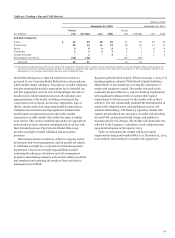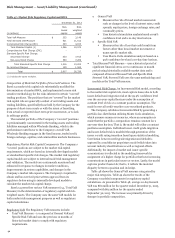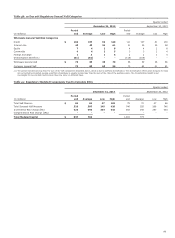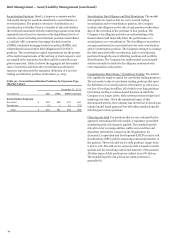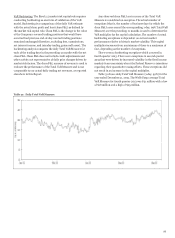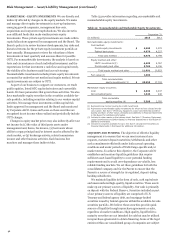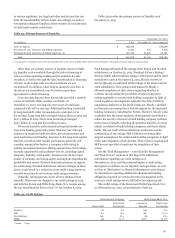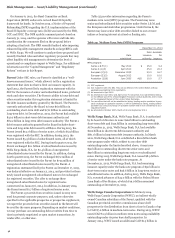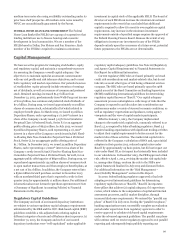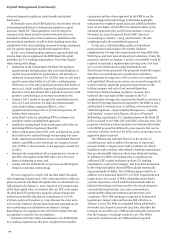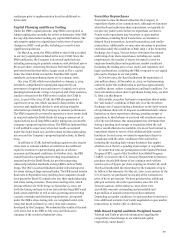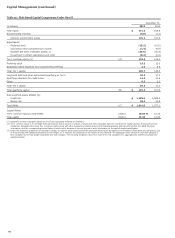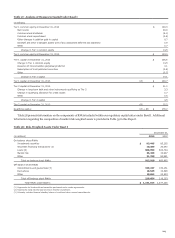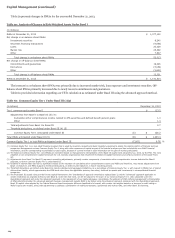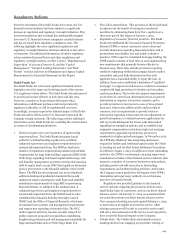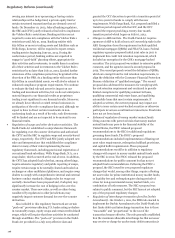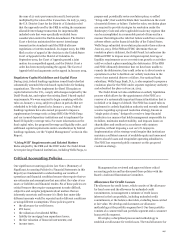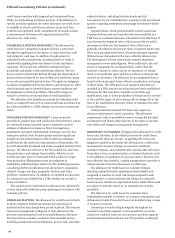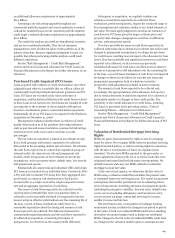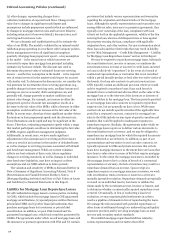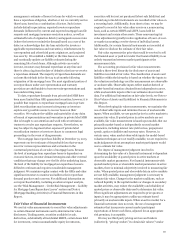Wells Fargo 2013 Annual Report Download - page 103
Download and view the complete annual report
Please find page 103 of the 2013 Wells Fargo annual report below. You can navigate through the pages in the report by either clicking on the pages listed below, or by using the keyword search tool below to find specific information within the annual report.surcharges prior to implementation based on additional or
future data.
Capital Planning and Stress Testing
Under the FRB’s capital plan rule, large BHCs are required to
submit capital plans annually for review to determine if the FRB
has any objections before making any capital distributions. The
rule requires updates to capital plans in the event of material
changes in a BHC’s risk profile, including as a result of any
significant acquisitions.
On March 14, 2013, the FRB notified us that it did not object
to our 2013 capital plan included in the 2013 CCAR. Since the
FRB notification, the Company took several capital actions,
including increasing its quarterly common stock dividend rate to
$0.30 per share, redeeming Wachovia Preferred Funding Corp.
preferred securities that will no longer count as Tier 1 capital
under the Dodd-Frank Act and the final Basel III capital
standards, and repurchasing shares of our common stock.
Our 2014 CCAR, which was submitted on January 3, 2014,
included a comprehensive capital plan supported by an
assessment of expected uses and sources of capital over a given
planning horizon under a range of expected and stress scenarios,
similar to the process the FRB used to conduct the CCAR in
2013. As part of the 2014 CCAR, the FRB also generated a
supervisory stress test, which assumed a sharp decline in the
economy and significant decline in asset pricing using the
information provided by the Company to estimate performance.
The FRB is expected to review the supervisory stress results both
as required under the Dodd-Frank Act using a common set of
capital actions for all large BHCs and by taking into account the
Company’s proposed capital actions. The FRB has indicated that
it will publish its supervisory stress test results as required
under the Dodd-Frank Act, and the related CCAR results taking
into account the Company’s proposed capital actions, in March
2014.
In addition to CCAR, federal banking regulators also require
stress tests to evaluate whether an institution has sufficient
capital to continue to operate during periods of adverse
economic and financial conditions. In October 2012, the FRB
issued final rules regarding stress testing requirements as
required under the Dodd-Frank Act provision imposing
enhanced prudential standards on large BHCs such as Wells
Fargo. The OCC issued and finalized similar rules during 2012
for stress testing of large national banks. The FRB issued interim
final rules in September 2013 clarifying how companies should
incorporate the Basel III capital rules into their capital planning
and stress testing exercises. These stress testing rules, which
became effective for Wells Fargo on November 15, 2012, set
forth the timing and type of stress test activities large BHCs and
banks must undertake as well as rules governing stress testing
controls, oversight and disclosure requirements. As required
under the FRB’s stress testing rule, we completed a mid-cycle
stress test based on March 31, 2013, data and scenarios
developed by the Company. We submitted the results of the mid-
cycle stress test to the FRB in July 2013 and disclosed a
summary of the results in September 2013.
Securities Repurchases
From time to time the Board authorizes the Company to
repurchase shares of our common stock. Although we announce
when the Board authorizes share repurchases, we typically do
not give any public notice before we repurchase our shares.
Future stock repurchases may be private or open-market
repurchases, including block transactions, accelerated or
delayed block transactions, forward transactions, and similar
transactions. Additionally, we may enter into plans to purchase
stock that satisfy the conditions of Rule 10b5-1 of the Securities
Exchange Act of 1934. Various factors determine the amount
and timing of our share repurchases, including our capital
requirements, the number of shares we expect to issue for
employee benefit plans and acquisitions, market conditions
(including the trading price of our stock), and regulatory and
legal considerations, including the FRB’s response to our capital
plan and to changes in our risk profile.
In October 2012, the Board authorized the repurchase of
200 million shares. At December 31, 2013, we had remaining
authority under this authorization to purchase approximately
74 million shares, subject to regulatory and legal conditions. For
more information about share repurchases during 2013, see Part
II, Item 2 in this Report.
Historically, our policy has been to repurchase shares under
the “safe harbor” conditions of Rule 10b-18 of the Securities
Exchange Act of 1934 including a limitation on the daily volume
of repurchases. Rule 10b-18 imposes an additional daily volume
limitation on share repurchases during a pending merger or
acquisition in which shares of our stock will constitute some or
all of the consideration. Our management may determine that
during a pending stock merger or acquisition when the safe
harbor would otherwise be available, it is in our best interest to
repurchase shares in excess of this additional daily volume
limitation. In such cases, we intend to repurchase shares in
compliance with the other conditions of the safe harbor,
including the standing daily volume limitation that applies
whether or not there is a pending stock merger or acquisition.
In connection with our participation in the Capital Purchase
Program (CPP), a part of the Troubled Asset Relief Program
(TARP), we issued to the U.S. Treasury Department warrants to
purchase 110,261,688 shares of our common stock with an
exercise price of $34.01 per share expiring on October 28, 2018.
The Board authorized the repurchase by the Company of up to
$1 billion of the warrants. On May 26, 2010, in an auction by the
U.S. Treasury, we purchased 70,165,963 of the warrants at a
price of $7.70 per warrant. We have purchased an additional
986,426 warrants, all on the open market, since the U.S.
Treasury auction. At December 31, 2013, there were
39,108,864 warrants outstanding and exercisable and
$452 million of unused warrant repurchase authority.
Depending on market conditions, we may purchase from time to
time additional warrants in privately negotiated or open market
transactions, by tender offer or otherwise.
Risk-Based Capital and Risk-Weighted Assets
Table 56 and Table 57 provide information regarding the
composition of and change in our risk-based capital,
respectively, under Basel I.
101


